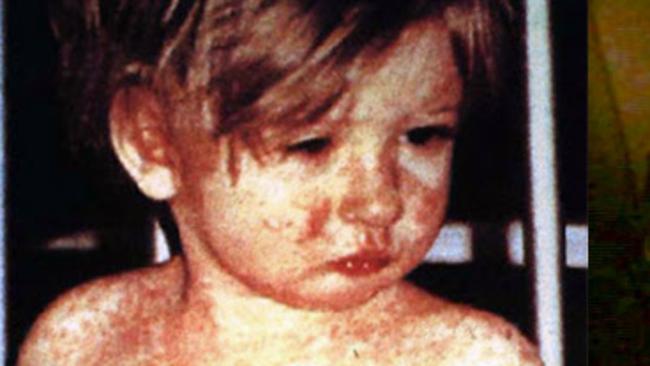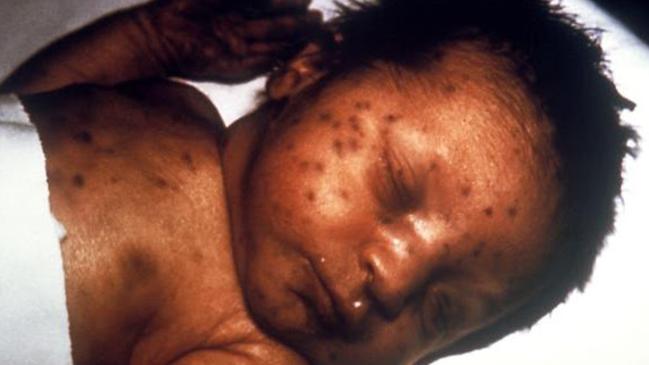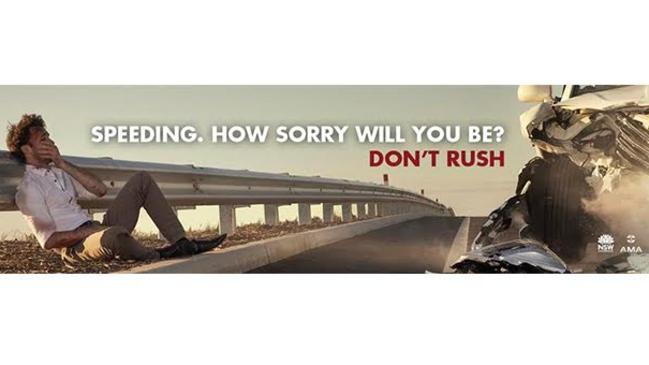Why a photo may be the answer to vaccine sceptics
THEY SAY a picture is worth a thousand words, and an image like this may be the answer to winning the war against anti-vaxxers.

THEY SAY a picture is worth a thousand words, and in the case of winning the war over anti-vaxxers, an image like this may be enough to change the mind of even the most extreme sceptics.
In a study conducted by PNAS, graphic images of children plagued with measles, mumps and rubella were shown to a group of parents who were sceptical about of the benefits of vaccination. After the intervention, the results revealed that some parents might change their view on vaccinations.

“It’s sort of appealing to directly confront people about their beliefs, but that sets up a context for an argument, and then they respond by arguing back,” Derek Powell, co-author on the study told Vocativ.
“If you tell people that these are contagious diseases and that there are serious benefits to getting vaccines, you can get improvements in people with negative attitudes toward vaccines.”
While debates, statistics and studies have proven to do little in changing the mind of anti-vaxxers, the study showed that scaring them with confronting photos may assist in changing their minds.
“We found that directing people’s attention to the risks posed by not getting vaccinated, like getting measles, mumps and rubella and the complications associated with those diseases, changed people’s attitudes positively towards vaccination — and that was for even the most sceptical participants in the study,” said Zachary Horne, a PhD student at the University of Illinois and co-author on the study
“Actually, the largest effect (was) for people who were the most sceptical.”

While the pictures of sick children are confronting, the NSW Centre for Road Safety questions whether graphic images will really have the impact they are aiming for.
Spokeswoman Angela Kamper told news.com.au that ‘shock-tactics’ do not work on an audience when trying to create awareness around an issue. The use of graphic imagery has been eliminated in all of their campaigns, as exposing an audience to ‘gore’ tends to remove a person from the scenario, with the ad proving ineffective.
“In terms of our ads — we show realistic images of what happen, but they aren’t gory or graphic. Because when they are like that, people tend to remove themselves and say that’s never going to happen to me,” she said.
“We are trying to tell people that you take this action, such as spending or drink driving, there can be consequences. Our research shows that exposing people to graphic images are not effective in changing driver behaviour.”
An example that has worked for the centre is the Drink Driving ‘Plan B’ campaign, where people give excuses as to why people get behind a wheel after consuming alcohol. Three years after its launch, the campaign continues to perform above industry average and has contributed to the 44% decline in alcohol related deaths since 2009.

So what will the use of confronting, realistic images and scenarios have on the mindset of anti-vaxxers?
“Basically, there’s no magic wand. Changing behaviour is a long-term project and you need to tackle in on a number of fronts. Advertising will change attitudes, but that won’t necessary change behaviour. To change behaviour you have to bring in a consequence,” high profile advertising creative director Jane Caro said.
She added “These images could be in intensive care wards, because people are putting children and other peoples children at risk [by not vaccinating].”
But whether confronting images would work in convincing Australian parents to vaccinate their children remains to be seen.
With only around 92% of five-year-old children fully immunised in Australia, the Australian Government Department of Health spoke of the importance of immunising children.
“Immunisation is critical for the health of children and the wider community. For immunisation to provide the greatest benefit, a sufficient number of people need to be vaccinated to halt the spread of bacteria and viruses that cause disease — this is known as herd immunity or community immunity,” a spokesperson said.
“The 2015-16 Budget provided $4.7 million in additional funding to support a range of communication activities to increase awareness and understanding of the National Immunisation Program. This included funding for resources and tools to support GPs and vaccination providers’ conversations with vaccine hesitant parents.”




